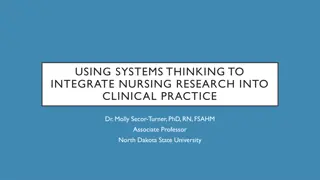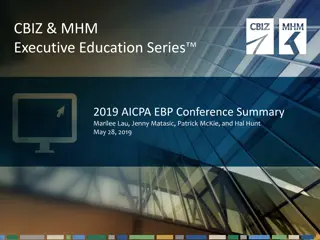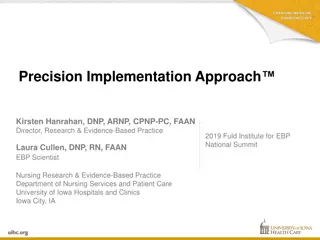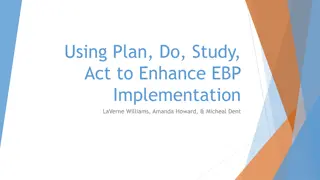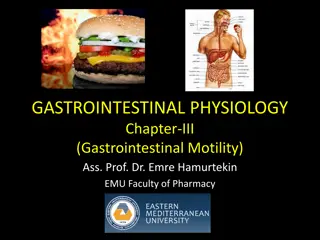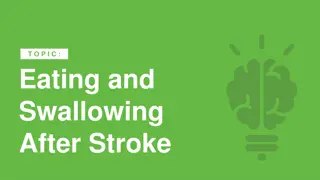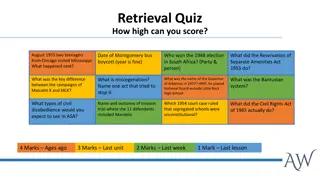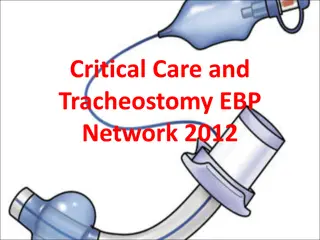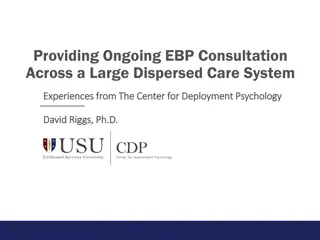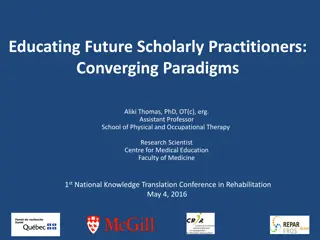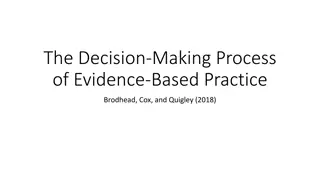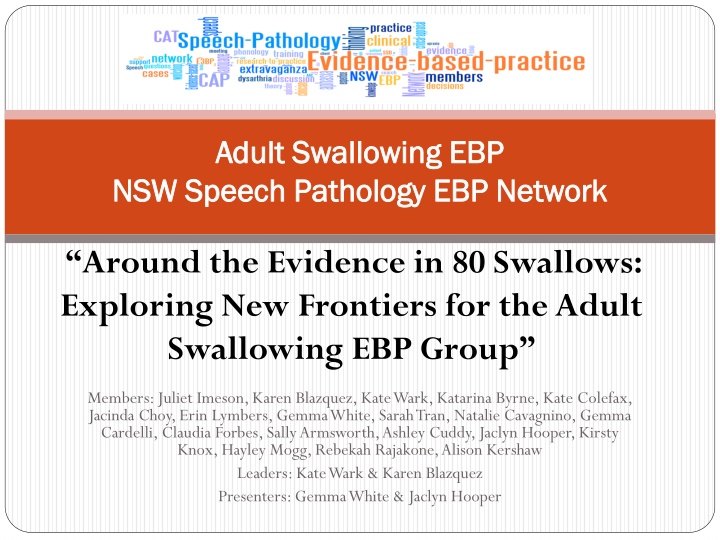
Exploring New Frontiers in Adult Swallowing Evidence-Based Practice
Join the NSW Speech Pathology EBP Network as they delve into the latest research on adult swallowing disorders. Discover key findings on dysphagia in the elderly, respiratory conditions, and more. Enhance your clinical practice through journal club discussions and PD updates. Stay informed with insights from the Sydney Swallow Lab Symposium.
Download Presentation

Please find below an Image/Link to download the presentation.
The content on the website is provided AS IS for your information and personal use only. It may not be sold, licensed, or shared on other websites without obtaining consent from the author. If you encounter any issues during the download, it is possible that the publisher has removed the file from their server.
You are allowed to download the files provided on this website for personal or commercial use, subject to the condition that they are used lawfully. All files are the property of their respective owners.
The content on the website is provided AS IS for your information and personal use only. It may not be sold, licensed, or shared on other websites without obtaining consent from the author.
E N D
Presentation Transcript
Adult Swallowing EBP Adult Swallowing EBP NSW Speech Pathology EBP Network NSW Speech Pathology EBP Network Around the Evidence in 80 Swallows: Exploring New Frontiers for the Adult Swallowing EBP Group Members: Juliet Imeson, Karen Blazquez, Kate Wark, Katarina Byrne, Kate Colefax, Jacinda Choy, Erin Lymbers, Gemma White, Sarah Tran, Natalie Cavagnino, Gemma Cardelli, Claudia Forbes, Sally Armsworth, Ashley Cuddy, Jaclyn Hooper, Kirsty Knox, Hayley Mogg, Rebekah Rajakone, Alison Kershaw Leaders: Kate Wark & Karen Blazquez Presenters: Gemma White & Jaclyn Hooper
Goals for 2019 Part 1) Journal club Themes picked and literature searches conducted by the group: 1. Dysphagia on the rise in the aged care population (26th Feb) 2. Swallowing and Respiratory Conditions (14th May) 3. The Deglutition Project (13th August) Averaging 2-4 papers each session Critically analyse articles in small groups, then regroup and present Take home message: how will we apply knowledge into everyday clinical practice? Updates from the Sydney Swallow Lab Symposium (Dr. Hans Bogaardt, USYD, 12th Nov) Part 2) PD updates
1. Dysphagia on the rise in the aged care 1. Dysphagia on the rise in the aged care population population Authors/Aim Summary Prospective cross sectional survey. 117 seniors (independently living) interviewed re: dysphagia. Asked about symptoms, risk/protective factors, socioemotional consequences. Lifetime prevalence of 38% - 33% reported dysphagia at time of study. Stroke, GORD, COPD and chronic pain associated with dysphagia. Dysphagia in the Elderly: Preliminary Evidence of Prevalence, Risk Factors, and Socioemotional Effects (Roy, Stemple, Merrill & Thomas 2007) The prevalence of oropharyngeal dysphagia in acute geriatric patients (Melgaard, Rodrigo- Domingo, Morch, 2018) Cross sectional observation study. 50% of acute geriatric patients at a North Denmark Regional Hospital presented with oropharyngeal dysphagia (N = 313). Minimal information on assessments used and criteria for diagnosis of dysphagia. 180 days mortality was 33%. Exclusion criteria: diagnosis of dementia/delirium nil comment on reason. Results suggested a systematic screening of all acute geriatric patients. Longitudinal study of symptoms of oropharyngeal dysphagia in the elderly community dwelling population (Nimmons et al., 2016) Longitudinal study - total of 528 participants. Sydney Swallow Questionnaire used sent in 2009 and again in 2012. Dementia was an exclusion criteria. Prevalence of dysphagia - 14.2% in 2009 and 13.4% in 2012. 19% of original cohort died by 2012. 19% of these had dysphagia in 2009. 106 people did survey in 2009 and not in 2012 unknown reason ?mortality.
2. Swallowing and Respiratory Conditions 2. Swallowing and Respiratory Conditions Authors Summary Outcomes of dysphagia initiation assessment in pulmonary rehab program (McKinstry et al., 2010) 8 week program (n=632). 1 hour dysphagia education, screening +/- assessment and management. Questionnaire showed increased knowledge of dysphagia. 27% who were screened had dysphagia. Statistically significant improvement in SWAL-QOL pre and post. Benefit to dysphagia education in patients with COPD. The effect of COPD on laryngopharyngeal sensitivity (Clayton et al., 2012) n=20 adults with COPD and n=11 controls. COPD patients have reduced laryngopharyngeal sensitivity (risk of silent asp) Link between inhalers and sensitivity and active smokers and sensitivity - ?causality No correlation with COPD and severity sensitivity The EAT-10 predicts aspiration in adults with stable COPD (Regan et al., 2017) EAT 10 completed pre clinical swallow evaluation and FEES (scored by PAS) Retrospective study (n=30 of COPD pts) Mean significant difference between EAT 10 aspirators and non aspirators Helpful screening tool to predict aspiration, but not diagnostic Swallowing function in chronic respiratory diseases: A systematic review (Ghannouchi et al., 2016) Systematic review - compared different respiratory diseases and swallow function. OSA- 68% had statistically significant swallow dysfunction independent of OSA, severity not a factor. Snoring pts had increased risk of developing subclinical OD independent of OSA COPD - swallow function compromised Need more research
3.The Deglutition Project 3. The Deglutition Project Authors Summary Elucidating Inconsistencies in Dysphagia Diagnostics: Redefining Normal (Plowman & Humbert, 2018) Case series. Study 1) 188 SLPs viewed a series of 5 VFSS and were required to judge as normal vs disordered. Study 2) 40 SLPs specializing in dysphagia were required to rate 6 swallow metrics (swallow reaction time, laryngeal vestibule closure, UES opening duration, pharyngeal transit time, superior hyoid excursion and anterior hyoid excursion) (on VFSS) as WNL, disordered, or unknown. Data collection from practicing SLPs in the US suggests low levels of agreement across clinicians and poor to moderate levels of accuracy for binary diagnostic ratings (disordered vs. non disordered) Detailed discussion about the education / training of dysphagia, and what is normal vs. dysfunction vs. disordered swallowing Omission of Dysphagia Therapies on Hospital discharge Communications (Kind et al., 2011) Retrospective Cohort Study (review of documentation for all strokes and #NOF patients billed for dysphagia during inpatient admission) 45 % of discharge summaries omitted all SLP dysphagia recommendations
4. Sydney Swallow Lab Symposium Summary of recent research from Hans Bogaardt: Rehab efficiency/dosage a focus of recent research. One repetition maximum from exercise physiology working at 70-80% of maximum for best results. Shaker: when do sternocleidomastoid muscles take over? While supine, 3% o f MVC reached, in full flexion, 17% of MVC. Found that 0-20% is maximum before sternocleidomastoids take over the Shaker crunch . EMST we use suprahyoid muscles more during a normal swallow compared with EMST. EMST not effective for targeting suprahyoid muscles Digastric muscles also used more in normal swallow compared with EMST. Suggests swallowing hard more effective for hyolaryngeal movement than EMST. IOPI also less activation compared with normal swallow. Increase in area of digastric muscles but MVC not reached (44.7% with IOPI, 54% with normal swallow). Good for lingual muscles, but not overall swallow. Hans bottom line: best therapy is just swallowing. E.g. 3-4 tubs yoghurt/day for Rx (if safe). Research on the horizon: CTAR, SEMG + Mendelsohn.
Clinical Bottom Lines 2019 Dysphagia is prevalent and on the rise in geriatric populations. Respiratory and dysphagia: COPD population are at risk of silent aspiration, EAT-10 is a helpful screening tool to predict aspiration but not diagnostic, more research required for dysphagia and respiratory disorders. Normal swallowing: poor intra and inter rater agreement in diagnosing a normal vs. dysfunctional vs. disordered swallow for binary diagnostic ratings. This has an impact on current diagnostic assessments in the clinical realm. Sydney Swallow Lab Symposium: dosage of swallow therapy needs to be considered for efficient rehab using 70-80% of maximum more useful, therefore consider shaker crunch rather than full range. Best therapy for swallowing = swallowing!
Major PD attended in 2019 Mark Elkin s workshop Critical Analysis of Research Papers for Speech Pathologists Ianessa Humbert The Deglutition Project Maggie-Lee Huckabee workshop Update in Dysphagia Practises Sydney Swallowing Lab Symposium SLHD VFSS Workshop 31st October SLHD FEES Workshop 1st October
2019 Summary Journal club style was well received by the group: Topics were relevant and meaningful (chosen by the group as per their clinical needs) The variety of dysphagia topics discussed and analysed were found to be stimulating More engagement observed given the group s large numbers and growing size: Breaking into smaller groups to critically analyse, then regroup and present Got through more content / articles than what would have been typically done if a CAT was completed
Plans for the future? Change in leadership with Karen Blazquez leaving. Jaclyn Hooper has volunteered to Co-Chair in 2020. Journal club style will continue in 2020: Greater focus on the use of critical appraisal resources (e.g. CASP template) to structure evaluation. New members encouraged to contact Co-Chairs should they be seeking a buddy to support them navigating the EBP/critical evaluation process. Survey 2019 has been distributed to members for feedback and planning for 2020.
References Clayton, N. A., Carnaby-Mann, G .D., Peters, M. J., & Ing, A. J. (2012). The effect of COPD on laryngopharyngeal sensitivity. Ear Nose Throat Journal, 91 (9), 370-374. Ghannouchi, I., Speyer, R., Doma, K., Cordier, R. & Verin, E. (2016). Swallowing function in chronic respiratory diseases: A systematic review. Respiratory Medicine, 117, 54-64. doi: 10.1016/j.rmed.2016.05.024 Kind, A., Anderson, P., Hind, J., Robbins, J. & Smith, M. (2011). Omission of Dysphagia Therapies on Hospital discharge Communications. Dysphagia, 26 (1), 49-61. doi:10.1007/s00455-009-9266-4 McKinstry, A., Tranter, M. & Sweeney, J. (2010). Outcomes of dysphagia initiation assessment in pulmonary rehab program. Dysphagia, 25 (2), 104-11. doi: 10.1007/s00455-009-9230-3 Melgaard, D., Rodrigo-Domingo, M., & M rch, M. (2018). The Prevalence of Oropharyngeal Dysphagia in Acute Geriatric Patients.Geriatrics,3(2), 15. doi: 10.3390/geriatrics3020015 Nimmons, D., Michou, E., Jones, M., Pendleton, N., Horan, M., & Hamdy, S. (2016). A Longitudinal Study of Symptoms of Oropharyngeal Dysphagia in an Elderly Community-Dwelling Population.Dysphagia,31(4), 560-566. doi: 10.1007/s00455-016-9715-9 Plowman, E.K. & Humbert, I. A. (2018): Elucidating inconsistencies in dysphagia diagnostics: Redefining normal. International Journal of Speech-Language Pathology, 1-8. doi: 10.1080/17549507.2018.1461931 Regan, J., Lawson, S. & De Aguiar, V. (2017). The EAT-10 predicts aspiration in adults with stable COPD. Dysphagia, 32 (5), 714-720. doi: 10.1007/s00455-017-9822-2. Roy, N., Stemple, J., Merrill, R., & Thomas, L. (2007). Dysphagia in the Elderly: Preliminary Evidence of Prevalence, Risk Factors, and Socioemotional Effects.Annals Of Otology, Rhinology & Laryngology,116(11), 858-865. doi: 10.1177/000348940711601112


